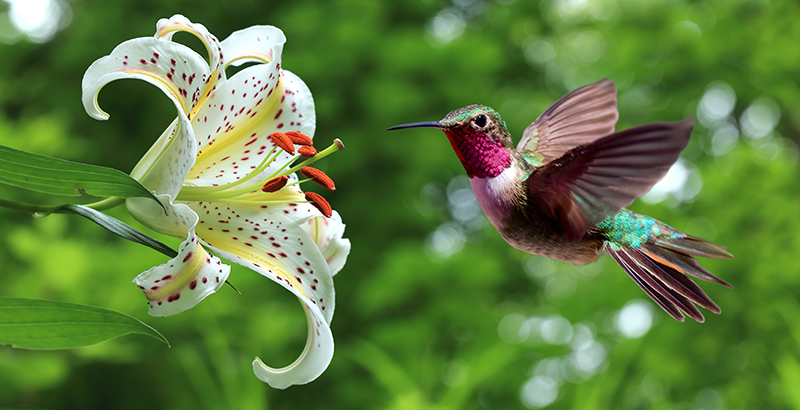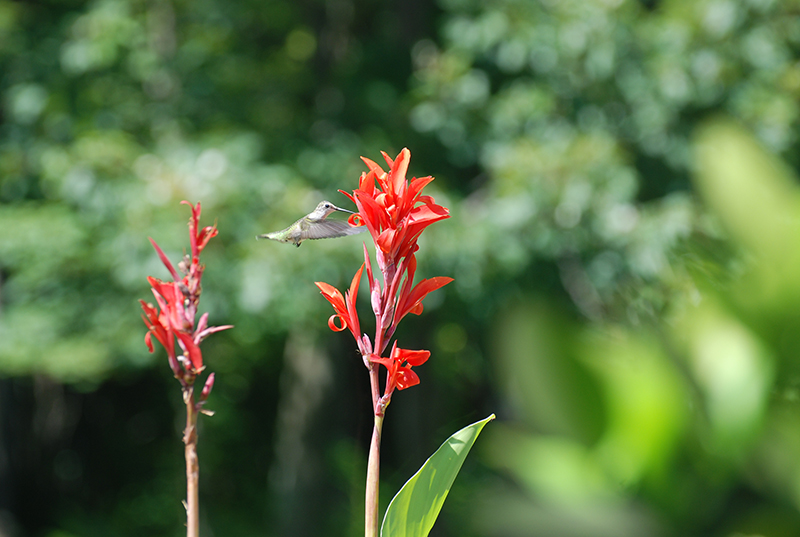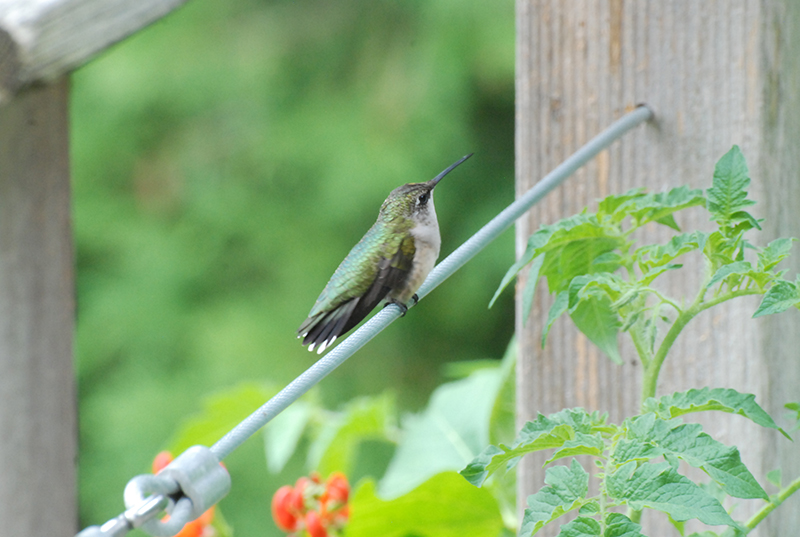By Julianne Labreche
Small but mighty’ is an apt descriptor for the ruby-throated hummingbird. Even though it weighs about the same as a Canadian nickel, every spring this tough, tiny bird makes an incredible journey north from Mexico and parts of Central America to many parts of Canada, including gardens, parks and forests here in eastern Ontario.

Hummingbirds are always welcome visitors with their beautiful hues of metallic green and ruby red. They are also amazingly fast and agile, fierce fighters when male confronts male in a hummingbird turf war. Hummingbirds have a heart rate of up to 1,260 beats per minute, so they burn calories quickly and constantly seek reliable nectar sources. Nectar accounts for about 90 percent of the bird’s diet.
One way to attract them is to hang a hummingbird feeder. Feeders come in various shapes and sizes. Th e recipe for nectar syrup is a mixture of four parts water and one part white sugar, boiled and then refrigerated until required. Of course, feeders need to be cleaned and rinsed every few days, especially in hot weather, otherwise deadly diseases spread through mould, algae and bacteria. Using honey or brown sugar as a sugar substitute also can harm hummingbirds and adding red dye can be potentially fatal.
A mix of plants and shrubs will provide a home for hummers during summer.
A better way to attract hummingbirds is to create a garden habitat that welcomes them with a diversity of natural food sources, water and safe spaces to rear their young. Planting a mixture of native and non-native plants and shrubs will provide a permanent home for hummers during their summers in the north.
This was exactly what I attempted last spring when I added more hummingbird-friendly flowering annuals, perennials, shrubs and climbing vines, hoping to bring them back to my garden. I hadn’t seen one in my garden since I moved into my Nepean home nearly 20 years ago. My natural science experiment paid off . By late summer, I was lucky and had a first sighting! What a joy to see a hummingbird in my garden. It was one of those magical moments that gave me hope for nature.
Plant Red Tubular Flowers

Hummingbirds use vision, not scent, to find nectar-rich flowers. Although they will visit different flowers, they are particularly attracted to red and orange tubular shaped flowers. The colours easily capture the attention of these fast-moving birds and the shape suits their long, needle-shaped beaks and grooved tongues. Unlike other birds, they hover in place in the air
around the blossoms.
Some native plants, such as the annual jewelweed (Impatiens capensis) with its tiny orange-coloured flowers may even influence the timing of their migration back south. Hummingbirds rely on this native plant as a nectar source during their fall migration. It grows in moist ditches and along creeks in the wild. Like any native plant, it should never be gathered from the wild but its seeds can be purchased from native plant nurseries locally.
Hummingbirds also are attracted to other native plants that gardeners can easily grow. These include red columbine (Aquilegia canadensis), scarlet bee balm (Monarda didyma), blazing star (Liatris spicata), butterfly weed (Asclepias tuberosa) and cardinal flowers (Lobelia cardinalis). Late last summer while delivering a potted cardinal flower to a neighbour, a hummingbird suddenly appeared and flew right to the flower as we chatted! They are bold little birds with a definite preference for certain plants.
Hummingbirds also benefit from a variety of non-native annuals and perennials, shrubs and trees that grow in their southern overwintering
spots. Growing scarlet runner beans in spring, red and orange nasturtiums, crocosmia and canna lilies will help gardeners who want to attract hummingbirds. Another useful plant is rocktrumpet (Dipladenia or Mandevilla), a tropical hanging vine with its fiery-red showy flowers. It grows quickly as a potted plant outdoors in Ottawa, but does need to be taken inside for winter.
Hummingbirds also enjoy a variety of flowering shrubs, including azalea (Rhododendron), flowering quince (Chaenomeles) and weigela.
Spring-blooming flowers of crab apple, lilac, peach, nectarine, apricot and cherry also attract them.
Nevertheless, native plants are preferred. Gardeners must take care not to purchase or plant invasive plant species that cause harm to natural, wild spaces. Always check labels and do sound research before growing something new.

Provide Water
Like most birds, hummingbirds love water, especially if it is running, dripping or misting in a spray so they can drink from it, bathe or fly through it. Various commercial fine spray sprinklers and misters are available to attract hummingbirds. If you are fortunate enough to have a natural water source such as a running stream or a homemade pond or waterfall, it will be a hummingbird magnet. A fountain with a circulating pump works well too.
Provide Safe Nesting Spaces
Along with food and water, a safe habitat is needed in a hummingbird garden. Hummingbirds are known to return to the same places each year, especially if there is plenty of nectar, safe nesting sites for their young, water and an adequate supply of live insects such as aphids, mosquitoes, gnats, fruit flies, small bee species and spiders. Insects provide the protein, vitamins and minerals needed for the young to survive. This is one reason why insects are always welcome to my garden.
Females usually lay two white eggs in little nests made from cobwebs, fluffy down from plants and bits of lichen. Nests are attached to a tree branch by sticky spider silk. The nest is well disguised, looking like a natural knob on the wood. Females care for the young. By mid-August, breeding season is nearly over. Males begin their migration south. Females and adult young follow later. Hummingbirds travel solo, not in flocks.
Hummingbirds will travel during daylight hours when nectar sources are more abundant, averaging about 32 kilometres a day. It is such a remarkable journey for a tiny bird, ten kilometres less than a marathon day after day, until they finally arrive at their winter home.
We can only marvel at their impressive navigation and flying skills and hope that these small but mighty birds will long continue to return to our gardens and wild spaces.
Hummingbird Facts
There are at least 23 different types of hummingbird species in North America.
The ruby-throated hummingbird (Archilochus colubris) is the only hummingbird species that returns to Canada, including the Ottawa region.
•Hummingbirds appear each year in Ottawa about early May. Migration times vary from year to year.
•Hummingbirds are the only birds that can fly backwards.
•For more information, see hummingbirdcentral.com.
Julianne Labreche is a master naturalist, a freelance writer and a member of the Master Gardeners of Ottawa-Carleton.






